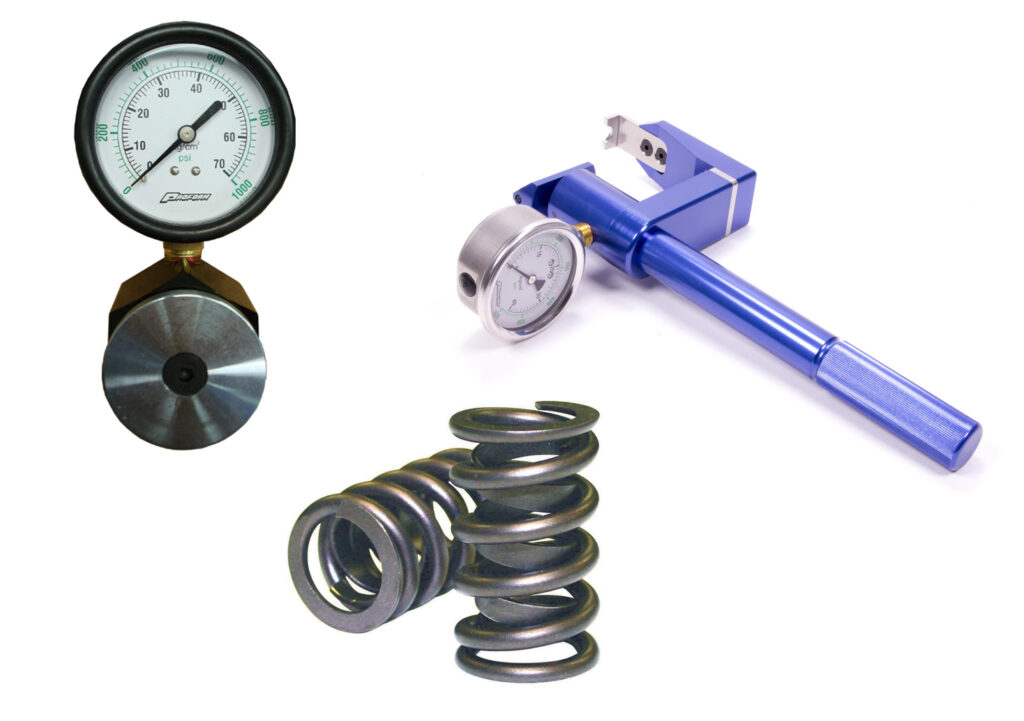Valve springs are among the most highly stressed components inside any high-revving race engine. So critical are they to the success of any race engine program that many professional racers change valve springs after each race. Although proper spring selection, installation, and periodical inspection are very important to the professional racer, they should not be overlooked by the sportsman racer either. Understanding what the valve spring is exposed to during normal engine operation is the first step in choosing the correct spring for a given application.
At the beginning of its cycle, the valve spring must compress as the valve begins to open. It must stop at maximum lift and then quickly return, allowing the valve to close. The motion must be smooth so the lifter can maintain full contact with the camshaft lobe at all times. For this to happen, the spring’s tension must be great enough to allow the lifter to follow the contour of the cam lobe, at idle and all the way through maximum RPM, for literally millions of cycles. If spring tension is too light, valve float and eventual engine damage can occur. If the spring is too stiff, friction-related horsepower loss and accelerated valve train wear will result.
According to cam experts from companies like Comp Cams and Crower, one of the most common causes of premature camshaft failure is the use of improper valve springs. This can include too high or too low spring pressure, or the springs can simply be plain worn out.
There are a number of issues that can arise with the valvetrain if proper care is not taken with valve spring selection. Valve float can cause a sudden, dramatic loss of power, and occurs when spring tension is not great enough to allow the lifter to follow the cam lobe properly. One part of the spring is trying to compress while another is trying to expand, causing the spring to overheat and resulting in permanent damage and lost tension. The spring’s erratic action causes the valve to hang open and suddenly snap closed.
This can destroy valve seats, break the heads off valves, shatter retainers, bend pushrods, and cause piston-to-valve interference, resulting in bent valves and damaged pistons. Improper tension, excessive wear, heavy valvetrain components, and repeated over-revving can also contribute to valve float.
Racers who run stiff springs and repeatedly twist their engines to excessively high RPM have experienced valve spring surge, the vibration caused by the natural frequency of the spring as it is cycled. Surge can also result in valve float, and can be avoided by using an opposing spring load or damper. Opposing type inner springs are wound in the opposite direction of the outer spring and create a dampening effect. Spring dampers of flat coiled steel may also be inserted between the outer and inner springs to prevent spring surge.
Let’s assume that the proper valve spring for our application is now in hand. What else must be done to assure that the springs last for a long time and continue to perform up to their full capacity? Installing them correctly is crucial. Because of larger diameter coils, inner springs, dampers, or all three, racing springs have larger outside diameters and smaller inside diameters. For this reason, the spring seats in the heads may have to be machined to a larger size, and valve guides may also require machining.
Valve spring manufacturers include any needed information about required machine work in the package with the springs and most cam manufacturers offer the proper tools to get the job done right. A specification card, packaged with every camshaft or valve spring set, lists the recommended installed height, seat pressure, and open pressure. Installed height is determined by how much the spring is compressed to arrive at proper seat pressure. Open pressure is the pressure exerted on the valve when it is in the open position, while seat pressure, the most critical, is the amount of pressure exerted on the valve while it is on the seat.

Now that the right springs have been installed with the proper height and pressures, periodic inspection, including testing the springs with a seat pressure tester, is a good idea. Use a seat pressure tester that will allow the springs to be checked without removing more than the valve cover. One more thing: Always follow the manufacturer’s recommendations. They not only take the time to produce a great product, but the extra time to print detailed instructions and recommendations to assure that their great product does what it’s supposed to do when it’s supposed to do it, and for as long as it’s supposed to do it.
One more thing: Always follow the manufacturer’s recommendations. They not only take the time to produce a great product, but the extra time to print detailed instructions and recommendations to assure that their great product does what it’s supposed to do when it’s supposed to do it, and for as long as it’s supposed to do it.